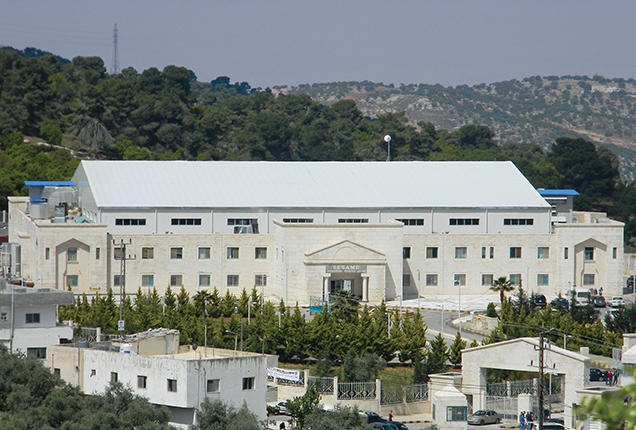Middle East synchrotron light source is set to start up
DOI: 10.1063/PT.3.3392
Twenty years in the making, SESAME (Synchrotron-light for Experimental Science and Applications in the Middle East) finally began debugging in November. If all stays on track, the light source, located in Allan, Jordan, will open for experiments next year.

The Middle East’s first synchrotron light source, SESAME, is on track to open for experiments next summer. Housed in a new building in Allan, Jordan, the 2.5 GeV facility is a regional collaboration of nine partners and counting.
SESAME

“Our fluffy dreams are becoming reality,” says Eliezer Rabinovici, a theoretical particle physicist at Hebrew University in Jerusalem. “When I touched the magnets, it was unbelievable.”
The 2.5 GeV SESAME will start with two beamlines, one for x-ray spectroscopic studies in the energy range of 3–30 keV and one for investigations in the range of 0.01–3 eV, which extends from the far-IR up to the visual. The machine can accommodate more than two dozen beamlines, some with wiggler and undulator insertion devices to increase the beam energy and flux.
Regional research
As at any synchrotron light source, the research program will be broad, spanning materials science, geology, biochemistry, industrial applications, and more. Some thrusts will be of regional interest, such as soil pollution, medicinal plants, archaeological studies that include ancient pottery and parchments, and investigation of a hepatitis C mutant that is prevalent in the Middle East.
In capability, SESAME will be comparable to other third-generation synchrotrons such as Soleil in France, the Canadian Light Source, and the Taiwan Photon Source. Some have higher energy or greater brightness, but SESAME will be competitive in many areas of research, says Chris Llewellyn Smith, director of energy research at Oxford University and president of the SESAME council. “And it will be the only light source in the Middle East.”
The SESAME partners are Bahrain, Cyprus, Egypt, Iran, Israel, Jordan, Pakistan, the Palestinian Authority, and Turkey. Several other countries in the region are observers or have expressed interest in joining. A turning point in propelling the project forward, says Rabinovici, came in 2012 when Israel, Turkey, and Jordan each pitched in $5 million; Iran has pledged the same amount.
So far, construction costs for SESAME have run to $80 million, of which $49 million has come from the member countries. The largest outside contribution, $11 million, was from the European Union, and Italy ponied up $2.9 million. In addition to cash and in-kind contributions, Jordan has provided land and a building for the facility.
“Something real to work with”
The SESAME dream goes back to November 1995, when 100 or so scientists gathered in a Bedouin tent in the Sinai desert to brainstorm about ways to increase understanding among people in the region. It was about two years after the initial Oslo Accord—the first face-to-face agreement between Israel and the Palestinian Liberation Organization, for which PLO chairman Yasser Arafat, Israeli prime minister Yitzhak Rabin, and Israeli foreign minister Shimon Peres received the Nobel Peace Prize in 1994. Rabinovici, who was present at the desert meeting, recalls that at the time, “there were many discussions of Arab–Israeli collaborations.”
Zehra Sayers, chair of the SESAME science committee and a biophysicist at Sabancı University near Istanbul, Turkey, joined the project in 2000. “People get fed up with wars, tensions, and disagreements,” she says. “I would hope that if they get to know each other, if they can talk to each other through science, they may someday be able to talk to each other about other things.” SESAME has already contributed to building understanding, she adds. “Its existence demonstrates that it is possible to work across the many divisions in the region.”
The project was seeded with a gift from Germany of a retired synchrotron, BESSY I. (See Physics Today, August 2002, page 27
Among the challenges still facing SESAME, says Llewellyn Smith, are to expand the user community in the region, raise money for the remaining beamlines, and provide workshops, labs, and a conference center. Perhaps the highest priority, he says, is to get a solar plant to power SESAME. Running the facility currently costs $375/MWh. At that rate, he says, SESAME members can’t afford to run at full capacity—a desired annual 10 GWh would run up a power bill of $3.75 million. “Payment of their annual contributions”—this year about $500 000—”is already a big challenge for most members, who generally have tiny science budgets,” he says. The estimate for a 6 MW solar power plant, not including land, is $8 million. For comparison, the cost of new beamlines is around $2 million to $5 million apiece.
The SESAME collaboration is modeled on CERN, which was started after World War II with the similar motivation of joining forces to build facilities beyond the means of individual member countries and using science as a means for forging good relations among former enemies. Like CERN, SESAME is under the umbrella of UNESCO.
“One must do a project where every side benefits and every side brings something to the project,” says Rabinovici. “It should be important to everybody, and everybody should be important to the project. We managed to do that.” The main thing, he says, “is you can’t compromise on good science.”
More about the Authors
Toni Feder. tfeder@aip.org
